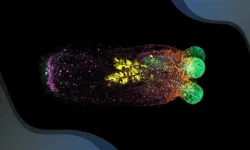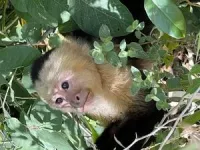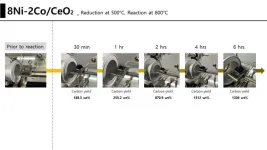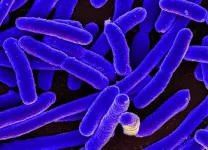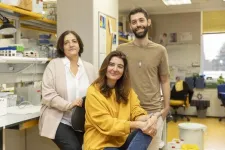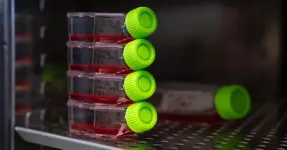(Press-News.org) Our bodies are remarkably skilled at adapting to changing environments. For example, whether amid summer heat or a winter freeze, our internal temperature remains steady at 37°C, thanks to a process called homeostasis. This hidden balancing act is vital for survival, enabling animals to maintain stable internal conditions even as the external world shifts. But recent research from the Ikmi Group at EMBL Heidelberg shows that homeostasis can extend beyond internal regulation and actively redefine an organism’s shape.
The starlet sea anemone (Nematostella vectensis) possesses remarkable regenerative abilities. Cut off its head or foot, and it simply grows a new one. Slice it in half, and each piece becomes a complete, fully functional anemone.
While some regenerating animals like salamanders and fish focus on restoring lost parts in proportion to what remains, this sea anemone takes a different approach. It reshapes its entire body to maintain the same overall form, even if that means adjusting parts that weren’t injured. This feature is also seen in flatworms and other animals with whole-body regenerative capabilities.
“Regeneration is about restoring function after tissue loss or damage,” explained Aissam Ikmi, EMBL Group Leader and senior author of a new study in the journal Developmental Cell. “Most research studies mainly consider patterns and sizes in regeneration, but our findings show that maintaining shape is also crucial – and it’s something the organism actively controls.”
The discovery began when Stephanie Cheung, a doctoral researcher in Ikmi’s group, noticed something unusual. When a sea anemone’s foot was injured, Cheung observed not only cell division at the wound site but also unexpected cell division at the opposite end of the body – the mouth area. This suggested the anemone was sending signals across its entire body in response to the injury.
To investigate this, the research team used a technique called spatial transcriptomics combined with advanced imaging. This allowed them to see which genes were active in different parts of the anemone’s body during regeneration. What they found was surprising: the injury triggered molecular changes both near and far from the wound. Cells moved and tissues reorganised, effectively reshaping the entire body.
Interestingly, the extent of the body reshaping depended on the injury’s severity. Losing a foot caused mild changes, while the anemone being cut in half led to significant remodelling. The team identified a family of enzymes called metalloproteases that became more active as more tissue was lost. These enzymes weren’t just working at the wound site; they were active throughout the body, helping to realign tissues.
“Metalloprotease activity has never been shown before in animals like this,” said Petrus Steenbergen, one of the study’s lead authors and an Ikmi Group Senior Research Technician. “I had to design and optimise experimental conditions for Nematostella based on the sparse literature available from other species. This took some time, but the final results were very rewarding.”
The breakthrough came when the researchers realised that all these changes aimed to restore the anemone’s original shape. By measuring the aspect ratio – the ratio of length to width – they found that the anemone returned to its pre-injury proportions. So, even if the anemone became smaller after an injury, it maintained the same shape.
“We were able to witness the body-wide coordination that drives this remodelling,” Ikmi explained. “This proportional response allows the anemone to restore its shape, highlighting how organisms like Nematostella interpret and respond to tissue loss in a way that’s scaled to the damage incurred.”
This research was a collaborative effort. Rik Korswagen’s team at the Hubrecht Institute in the Netherlands helped implement spatial transcriptomics in the sea anemone. Oliver Stegle’s team at EMBL Heidelberg and the German Cancer Research Center (DKFZ) contributed bioinformatics expertise and the statistical methods needed to deal with the spatial gene expression data.
“It was a pleasure to puzzle out the findings of the study together by uniting the team’s expertise in data analysis and cell biology,” said Tobias Gerber, another of the study’s lead authors. “This work was a truly collaborative journey, and I am glad I was part of it.”
Looking ahead, Ikmi and his team are excited to explore new questions. “The next big question is why maintaining shape is so important,” Ikmi said. “And how does the organism sense its own shape? How does it know what it currently looks like?”
With the remarkable starlet sea anemone as their model, they’re eager to uncover more secrets about how organisms heal and maintain balance.
END
Sea anemone study shows how animals stay ‘in shape’
Scientists have shown how regenerating sea anemones restore their shape following a major injury
2024-11-29
ELSE PRESS RELEASES FROM THIS DATE:
KIER unveils catalyst innovations for sustainable turquoise hydrogen solutions
2024-11-29
Dr. Woohyun Kim's research team from the Hydrogen Research Department at the Korea Institute of Energy Research (KIER) has successfully developed an innovative nickel-cobalt composite catalyst that can accelerate the production and commercialization of turquoise hydrogen.*
*Turquoise Hydrogen: A technology that produces hydrogen and carbon by decomposing hydrocarbons such as methane (CH₄) (CH₄ → C + 2H₂). Unlike gray hydrogen, the most widely used hydrogen production technology, ...
Bacteria ditch tags to dodge antibiotics
2024-11-29
Bacteria modify their ribosomes when exposed to widely used antibiotics, according to research published today in Nature Communications. The subtle changes might be enough to alter the binding site of drug targets and constitute a possible new mechanism of antibiotic resistance.
Escherichia coli is a common bacterium which is often harmless but can cause serious infections. The researchers exposed E. coli to streptomycin and kasugamycin, two drugs which treat bacterial infections. Streptomycin has been a staple in treating tuberculosis and other infections since the 1940s, while kasugamycin is less known but crucial in agricultural settings ...
New insights in plant response to high temperatures and drought
2024-11-29
Ghent, 29 November 2024 – We are increasingly confronted with the impacts of climate change, with failed harvests being only one example. Addressing these challenges requires multifaceted approaches, including making plants more resilient. An international research team led by researchers at VIB-UGent has unraveled how the opening and closing of stomata - tiny pores on leaves – is regulated in response to high temperatures and drought. These new insights, published in Nature Plants, pave the way for developing climate change-ready crops.
Global climate change affects more and more people, with extreme weather conditions ...
Strategies for safe and equitable access to water: a catalyst for global peace and security
2024-11-29
Water can be a catalyst for peace and security with a critical role in preventing conflicts and promoting cooperation among communities and nations - but only if managed equitably and sustainably, a new study reveals.
Experts have devised a blueprint to ensure safe, equitable and sustainable global access to clean water. The seven-point strategy will allow water challenges to be governed effectively so they do not create conflict when access is restricted or usage unfairly shared.
Publishing ...
CNIO opens up new research pathways against paediatric cancer Ewing sarcoma by discovering mechanisms that make it more aggressive
2024-11-29
Ewing sarcoma is a tumour of the bones and soft tissues that occurs in children and young people. A quarter of patients do not respond well to therapy.
The group led by Ana Losada, at Spain’s National Cancer Research Centre (CNIO), has discovered an alteration in the most aggressive cases that affects genes never previously related to this disease.
This finding expands the list of potential prognostic markers and therapeutic targets in the most aggressive cases of Ewing sarcoma.
The new research is published in EMBO Reports.
Ewing sarcoma is a tumour of the bones and soft tissues that occurs in children and young people. ...
Disease severity staging system for NOTCH3-associated small vessel disease, including CADASIL
2024-11-29
About The Study: The findings of this study suggest the NOTCH3-associated small vessel disease (NOTCH3-SVD) staging system will help to better harmonize NOTCH3-SVD and cerebral autosomal dominant arteriopathy with subcortical infarcts and leukoencephalopathy (CADASIL) cohort studies and registries; may improve individualized disease counseling, monitoring, and clinical management; and may facilitate patient stratification in clinical trials.
Corresponding Authors: To contact the corresponding ...
Satellite evidence bolsters case that climate change caused mass elephant die-off
2024-11-29
A new study led by King’s College London has provided further evidence that the deaths of 350 African elephants in Botswana during 2020 were the result of drinking from water holes where toxic algae populations had exploded due to climate change.
The lead author of the report says their analysis shows animals were very likely poisoned by watering holes where toxic blooms of blue-green algae, or cyanobacteria, had developed after a very wet year followed a very dry one.
Davide Lomeo, a PhD student in the Department of Geography at King’s College London and co-supervised by Plymouth Marine Laboratory (PML) and ...
Unique killer whale pod may have acquired special skills to hunt the world’s largest fish
2024-11-29
Killer whales can feed on marine mammals, turtles, and fish. In the Gulf of California, a pod might have picked up new skills that help them hunt whale sharks – the world’s largest fish, growing up to 18 meters long.
Whale sharks feed at aggregation sites in the Gulf of California, sometimes while they are still young and smaller. During this life-stage, they are more vulnerable to predation, and anecdotal evidence suggests orcas could be hunting them. Now, researchers in Mexico have reported four separate hunting events.
“We show how orcas displayed a collaboratively hunting technique on whale sharks, characterized by ...
Emory-led Lancet review highlights racial disparities in sudden cardiac arrest and death among athletes
2024-11-29
UNDER STRICT EMBARGO UNTIL 6:30 PM November 28, 2024:
A recent major review of data published by the Lancet and led by Emory sports cardiologist Jonathan Kim, MD, shows that Black athletes are approximately five times more likely to experience sudden cardiac arrest (SCA) and sudden cardiac death (SCD) compared to White athletes, despite some evidence of a decline in rates of SCD overall. SCA and SCD have historically been a leading cause of mortality among athletes, particularly those involved in high-intensity sports.
The disparities in SCA/D rates highlights the need for increased research into the social determinants of health in younger athletes, a topic that remains ...
A new approach to predicting malaria drug resistance
2024-11-28
Researchers at University of California San Diego analyzed the genomes of hundreds of malaria parasites to determine which genetic variants are most likely to confer drug resistance. The findings, published in Science, could help scientists use machine learning to predict antimalarial drug resistance and more effectively prioritize the most promising experimental treatments for further development. The approach could also help predict treatment resistance in other infectious diseases, and even cancer.
“A lot of drug resistance research can only look at one chemical agent at a time, but what we’ve been able to do here is create a roadmap ...
LAST 30 PRESS RELEASES:
Heart-brain connection: international study reveals the role of the vagus nerve in keeping the heart young
Researchers identify Rb1 as a predictive biomarker for a new therapeutic strategy in some breast cancers
Survey reveals ethical gaps slowing AI adoption in pediatric surgery
Stimulant ADHD medications work differently than thought
AI overestimates how smart people are, according to HSE economists
HSE researchers create genome-wide map of quadruplexes
Scientists boost cell "powerhouses" to burn more calories
Automatic label checking: The missing step in making reliable medical AI
Low daily alcohol intake linked to 50% heightened mouth cancer risk in India
American Meteorological Society announces Rick Spinrad as 2026 President-Elect
Biomass-based carbon capture spotlighted in newly released global climate webinar recording
Illuminating invisible nano pollutants: advanced bioimaging tracks the full journey of emerging nanoscale contaminants in living systems
How does age affect recovery from spinal cord injury?
Novel AI tool offers prognosis for patients with head and neck cancer
Fathers’ microplastic exposure tied to their children’s metabolic problems
Research validates laboratory model for studying high-grade serous ovarian cancer
SIR 2026 delivers transformative breakthroughs in minimally invasive medicine to improve patient care
Stem Cell Reports most downloaded papers of 2025 highlight the breadth and impact of stem cell research
Oxford-led study estimates NHS spends around 3% of its primary and secondary care budget on the health impacts of heat and cold in England
A researcher’s long quest leads to a smart composite breakthrough
Urban wild bees act as “microbial sensors” of city health.
New study finds where you live affects recovery after a hip fracture
Forecasting the impact of fully automated vehicle adoption on US road traffic injuries
Alcohol-related hospitalizations from 2016 to 2022
Semaglutide and hospitalizations in patients with obesity and established cardiovascular disease
Researchers ‘listen in’ to embryo-mother interactions during implantation using a culture system replicating the womb lining
How changing your diet could help save the world
How to make AI truly scalable and reliable for real-time traffic assignment?
Beyond fragmented markets: A new framework for efficient and stable ride-pooling
Can shape priors make road perception more reliable for autonomous driving?
[Press-News.org] Sea anemone study shows how animals stay ‘in shape’Scientists have shown how regenerating sea anemones restore their shape following a major injury
